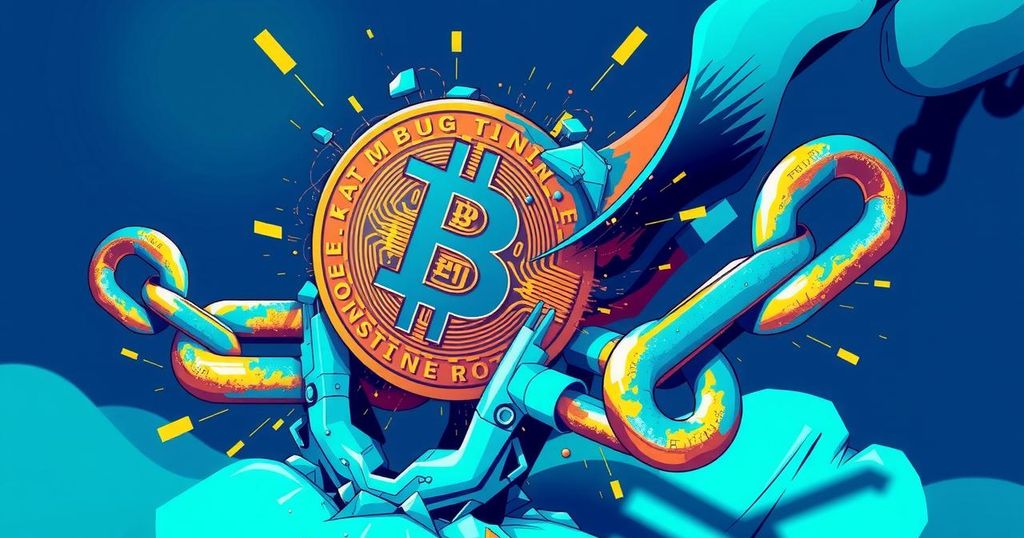VanEck’s Report: Bitcoin’s Short-lived Separation from Traditional Markets
In April 2025, VanEck revealed Bitcoin briefly outperformed equities, hinting at potential as a macro hedge. However, Bitcoin’s quick re-alignment with traditional markets suggests it hasn’t fully decoupled. Corporate BTC accumulation surged, alongside growing interest in Bitcoin as a hedge against traditional finance risks. Despite Bitcoin’s strength, the broader crypto market remains weak, illustrating a complex landscape ahead.
In its April 2025 Digital Assets Monthly recap, VanEck highlighted Bitcoin’s (BTC) performance during a particularly turbulent month. The report indicated that Bitcoin managed to outperform equities, showcasing its potential as a macro hedge. Despite this, Bitcoin’s return to correlated behaviour with traditional markets suggests that it’s not quite ready to stand alone just yet.
Bitcoin briefly exhibited a decoupling from other markets like stocks. Matthew Sigel, Head of Digital Assets Research at VanEck, pointed out that this separation was noted in the week ending April 6. This moment coincided with US President Donald Trump’s announcement of new tariff measures that prompted a global selloff. While equity indices like the S&P 500 tumbled, Bitcoin notably rose from $81,500 to over $84,500, suggesting a shift in investor sentiment. However, this momentum proved to be ephemeral, as Bitcoin’s price action eventually re-aligned with equities.
Using data from Artemis XYZ, VanEck tracked Bitcoin’s correlation with the S&P 500, observing that the 30-day correlation dipped below 0.25 in early April, only to rebound to 0.55 by the end of the month. “Bitcoin has not meaningfully decoupled,” the report clearly stated.
In terms of returns, Bitcoin increased by 13% in April, significantly outperforming the NASDAQ, which recorded a 1% loss, and the S&P 500, which remained nearly flat. Remarkably, during this period, Bitcoin’s volatility decreased by 4%, while that of equities noticeably doubled amid rising geopolitical tensions.
Despite the short-term uncertainties, VanEck has begun to see indications of a structural shift in market dynamics. There appears to be an increasing interest from both sovereign and institutional entities, viewing Bitcoin as a valuable long-term asset for macro hedging. Sigel remarked, “Structural tailwinds are forming. Bitcoin continues to find support as a sovereign, uncorrelated asset.”
The report even highlighted examples, like Venezuela and Russia, where Bitcoin is being utilised in international trade, as possible early indicators of this transition. Additionally, corporate accumulation of Bitcoin surged in April, with significant purchases reported by companies like Strategy (formerly MicroStrategy), which acquired 25,400 BTC. Other notable participants included Metaplanet and Semler Scientific.
Moreover, firms like Softbank, Tether, and Cantor Fitzgerald have combined forces to create a new entity, 21 Capital, with aspirations to acquire $3 billion worth of Bitcoin. Following suit, Standard Chartered suggested that Bitcoin is evolving into a hedge against traditional finance (TradFi) and US Treasury risk. Geoff Kendrick, Head of Digital Asset Research at Standard Chartered, stated, “I think Bitcoin is a hedge against both TradFi and US Treasury risks.”
However, the broader cryptocurrency market appears less resilient overall. VanEck reported that several altcoins struggled, particularly meme coins and speculative DeFi AI tokens. The MarketVector Smart Contract Leaders Index fell by 5% in April, and alarmingly, it has dropped 34% year-to-date. Solana was one of the few exceptions, enjoying a 16% increase driven by network upgrades and rising institutional interest.
Meanwhile, Ethereum faced challenges, declining by 3% and losing its fee revenue share, which plummeted from 74% to a mere 14% over the past two years. Overall, the altcoin situation seemed bearish, with a notable decline in trading volumes for meme coins, which have dropped by a staggering 93% from January to March.
In conclusion, while Bitcoin has not completely severed its ties with other risk assets, the groundwork for potential long-term decoupling appears to be quietly forming, as demonstrated by some discerning trends in performance and investor behaviour.
Disclaimer.




Post Comment